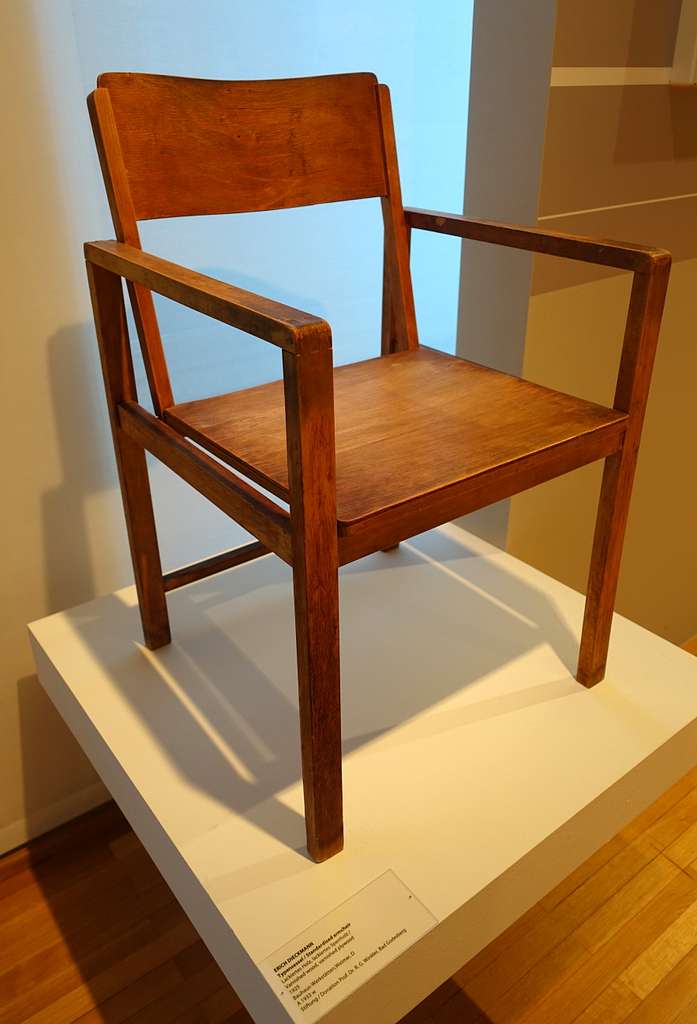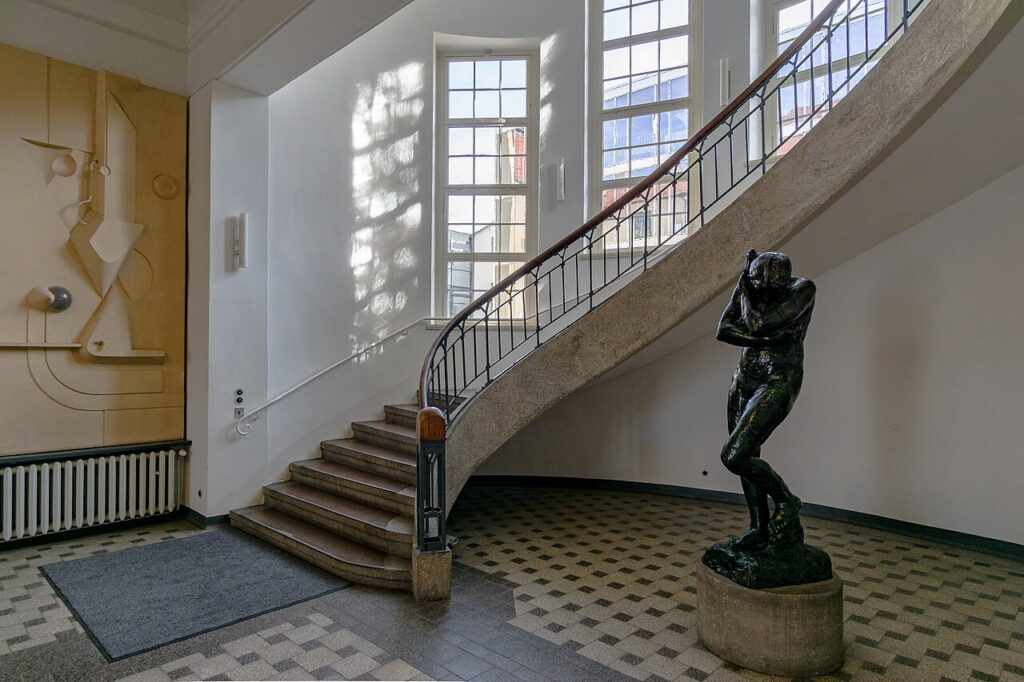Imagine a world rebuilt from the ashes of war, where artists dared to blend beauty with everyday utility. That spark ignited in 1919, when the Bauhaus school opened its doors in Weimar, Germany. Fast forward to 2019, and the centenary celebrations lit up cities across the country, honoring a movement that reshaped how we live, work, and create. Founded by architect Walter Gropius amid the chaos of post-World War I Europe, the Bauhaus lasted just 14 years before Nazi pressure forced its closure in 1933. Yet its ideas endure, influencing everything from sleek skyscrapers to the chair you’re sitting in. What made this short-lived school so revolutionary? Let’s dive in.
Roots in a Ravaged Europe: Why Bauhaus Emerged
Europe in 1919 was a landscape of ruins. World War I had shattered empires, economies, and old ways of thinking. Germany, defeated and reeling from the Treaty of Versailles, faced hyperinflation and social upheaval. Artists and thinkers sought a fresh start, one that could heal through creativity. Enter Walter Gropius, who envisioned a school that united fine arts, crafts, and technology. As he proclaimed in the Bauhaus manifesto, the goal was to create “a new guild of craftsmen, without the class distinctions which raise an arrogant barrier between craftsman and artist”.
Gropius drew inspiration from the Deutscher Werkbund, a pre-war group pushing for better industrial design, and the Arts and Crafts movement led by figures like William Morris. But Bauhaus went further. It emerged as a response to industrialization’s dehumanizing effects, aiming to make art accessible and functional for the masses. In Weimar, a city rich with cultural history (home to Goethe and Schiller), the school began as a radical experiment. Students from diverse backgrounds studied materials, color theory, and form in a preliminary course, often led by innovative teachers. This wasn’t just education. It was a blueprint for rebuilding society.
Why did it resonate? In a time of scarcity, Bauhaus preached efficiency and optimism. Picture workshops buzzing with energy, where painters collaborated with weavers and architects. The movement captured the era’s spirit: forward-looking, democratic, and unafraid of machines.
Core Principles: Form, Function, and Radical Simplicity
At its heart, Bauhaus boiled down to a few bold ideas. Functionality reigned supreme. “Form follows function,” a phrase often linked to the school, meant designs should serve their purpose without unnecessary frills. Think of it as stripping away the ornate excesses of the Victorian age to reveal clean, honest structures.
Unification of art and craft was another pillar. Gropius dreamed of erasing divides between “high” art and everyday making, creating what he called a Gesamtkunstwerk, or total work of art. Materials were used truthfully, no hiding rough edges behind decoration. Steel, glass, and concrete became stars, celebrated for their strength and modernity. And the approach to form? Radical. Geometric shapes, minimalism, and smart resource use defined the aesthetic. “There is no need for additional ornamenting,” one principle stated. “They are just fine as they are”.
These ideas weren’t abstract. They shaped prototypes for mass production, emphasizing simplicity and constant innovation. In workshops, students experimented with new technologies, turning constraints into creativity. The result? Designs that felt timeless yet utterly modern.

Icons of the Movement: Visionaries Who Shaped Bauhaus
No story of Bauhaus is complete without its luminaries. Walter Gropius, the founder, was the driving force. Born in Berlin in 1883, he trained under Peter Behrens and co-designed the groundbreaking Fagus Factory in 1911, a glass-and-steel marvel that foreshadowed modernism. As Bauhaus director from 1919 to 1928, Gropius steered the school through relocations and political storms, always advocating for art’s role in industry.
Paul Klee brought whimsy and theory. Joining in 1921, the Swiss painter taught design courses, blending abstraction with spiritual depth. His works, like the 1927 Carpet, drew from diverse influences, including North African textiles, to explore form and color. Klee’s classes immersed students in color theory and formal relationships, fostering creativity that echoed in later abstract art.
Wassily Kandinsky, a Russian pioneer of abstraction, added intellectual fire. From 1922, he led wall-painting workshops, emphasizing non-objective art and spiritual expression. His geometric compositions influenced Bauhaus typography and graphics, pushing boundaries between art and design.
Ludwig Mies van der Rohe, the final director from 1930 to 1933, epitomized “less is more.” Taking over in Berlin, he transformed the school into a hub for architecture, focusing on open spaces and minimalism. His mantra shaped icons like the Barcelona Pavilion, with its sleek marble and chrome.
And let’s not forget Marcel Breuer, a student turned master. At 23, he headed the furniture workshop, inventing the cantilever chair from tubular steel. Inspired by bicycle handlebars, his designs, like the Wassily Chair, symbolized freedom and modernity: lightweight, springy, and mass-producible.
These figures didn’t just teach. They lived the Bauhaus ethos, collaborating on projects that blurred lines between disciplines.
Timeless Creations: Describing the Icons
Step into the Bauhaus Building in Dessau, designed by Gropius in 1925-1926. Its glass curtain walls flood interiors with light, creating a transparent box that feels alive, almost breathing. No grand entrances here, just functional elegance, with workshops and studios integrated seamlessly. It’s a manifesto in concrete and steel, as noted by the Bauhaus Dessau Foundation.
Marcel Breuer’s furniture? Revolutionary. Picture his tubular-steel chairs: slender frames curving gracefully, supporting taut fabric seats that seem to float. The Wassily Chair, named for Kandinsky, uses chrome-plated steel for a sleek, industrial sheen, perfect for modern living. Or his nesting tables by Josef Albers, stacking like geometric puzzles.
Graphic designs and typographies shone too. Herbert Bayer’s universal alphabet ditched capitals for clean, sans-serif letters, influencing logos we see today. Textiles by Anni Albers wove bold patterns, turning fabric into art. And don’t overlook the ceramics and metalwork, like Marianne Brandt’s teapots: spherical, metallic orbs that balance form and utility.
These works weren’t static. They pulsed with narrative, inviting users to interact, as if the objects whispered stories of innovation.
Political Tensions and a Forced End
Bauhaus thrived amid turmoil, but politics loomed large. Its avant-garde ideals clashed with conservative forces. In Weimar, local authorities viewed it as too radical, forcing a move to Dessau in 1925. There, under Mayor Fritz Hesse’s support, it flourished, but Nazi rise brought scrutiny. Labeled “degenerate” and communist-leaning, the school faced raids.
By 1932, Dessau closed it, prompting a brief stint in Berlin under Mies. Yet in 1933, Gestapo seals shut the doors. Faculty fled, scattering ideas worldwide. This tension, between utopian vision and harsh reality, underscored Bauhaus’s fragility. As Gropius later reflected, it was a fight for creative freedom.
Global Legacy: From Exile to Everywhere
Exile propelled Bauhaus globally. Many emigrated to the U.S., seeding modernism. Mies became director of architecture at the Illinois Institute of Technology in Chicago, designing the Seagram Building, a glass tower of refined simplicity. Gropius taught at Harvard, influencing generations. Josef Albers founded Black Mountain College, a Bauhaus-inspired haven in North Carolina.
The impact rippled. In Tel Aviv, the White City boasts over 4,000 Bauhaus-style buildings, a UNESCO site, built by Jewish émigrés. Today, schools like the Ulm School of Design carry the torch, emphasizing interdisciplinary work.
Bauhaus in the Modern World: Everyday Influences
Look around. Bauhaus aesthetics shape IKEA furniture, with its flat-pack efficiency and clean lines. Logos like Apple’s draw from Bayer’s typography: simple, geometric, functional. Architecture? Skyscrapers by firms like SOM echo Mies’s grids. In digital design, user interfaces prioritize minimalism, much like Bauhaus’s “smart use of resources”.
Even sustainable design nods to it. Bauhaus’s emphasis on efficiency aligns with today’s eco-conscious ethos, recycling materials and minimizing waste. From Breuer-inspired cantilever chairs in cafes to modular homes, the legacy lives.
Celebrating the Centenary: Germany’s Vibrant Revival
2019 brought a nationwide party. The Opening Festival in Berlin, from January 16-24 at the Akademie der Künste, featured performances exploring body, space, and machine. In Weimar, the new Bauhaus Museum opened, showcasing artifacts from the school’s birth. Dessau’s Bauhaus Building hosted exhibits on its architecture, per the Bauhaus Dessau Foundation.
Berlin’s Bauhaus Week, August 31 to September 8, turned the city into a festival hub with installations, workshops, and transnational events. The Haus der Kulturen der Welt’s “Bauhaus Imaginista” ran March 15 to June 10, tracing global connections. These, organized by entities like the Bauhaus-Archiv and supported by official sites like bauhaus100.de, drew thousands, reigniting interest.

Why Bauhaus Still Matters: A Reflection and Call
In our era of mass production, where sustainability battles waste and digital tools redefine creation, Bauhaus whispers timeless lessons. It reminds us that design isn’t just about looks. It’s about purpose, unity, and innovation. Why cling to the past? Because in a fragmented world, its ideals foster connection.
Ready to experience it? Visit Dessau’s Masters’ Houses or Berlin’s Bauhaus Archive. Or simply redesign your space with function in mind. Bauhaus isn’t history. It’s a blueprint for tomorrow.
